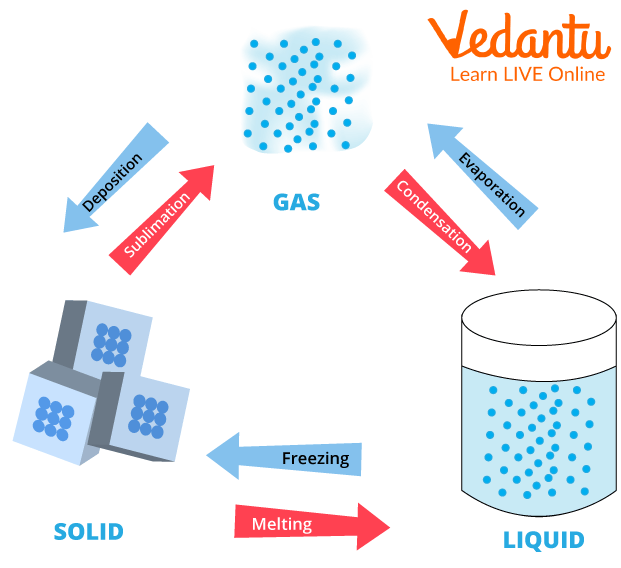




What Happens on Heating a Solid?
By heating a matter you can change its state. So, upon heating a solid you can change it to a Liquid state. This process of conversion of solid to liquid through heating is called Melting. When we apply heat to the solid, the rise in temperature helps the molecules in the solid to break their intermolecular forces and become less closely packed, hence changing their state. For example, if you heat ice, it is converted to water.
Liquid Heating
Just as solids change their form to liquids upon heating, liquids also tend to change their form to a gaseous state. This process of conversion of liquid to a gaseous state while applying heat is called evaporation. For example, when you heat water it turns into water vapours. This conversion also occurs because the energy provided by heating helps the water molecules to break their intermolecular forces and move apart from each other, hence adopting the molecular structure of gases, thereby changing into water vapours.
Exception: However, there exists a liquid that defies this inherent characteristic of liquids and instead of transforming into the gaseous state, it turns into the solid state. This anomaly is exhibited by a solution composed of α-cyclodextrin (αCD), water and 4-methylpyridine (4MP). When you heat this mixture between 45 degrees celsius to 75 degrees celsius, instead of turning to gas, it turns into a solid and turns back to liquid when cooled down.
Effect of Pressure on States of Matter
Pressure can be used to change the states of matter. When we apply pressure to gases, they are converted to liquids and when we do the same to liquids they are converted to solids. When we apply pressure to a state of matter, the molecules in it come closer to each other and hence the state of that particular matter changes.
Learning by Doing
Q1) What is the process of conversion of liquids to gases called?
Condensation
Freezing
Melting
Evaporation
Ans: d) Evaporation
Q2) What is the process of conversion of solids to liquids called?
Condensation
Freezing
Melting
Evaporation
Ans: c) Melting
Solved Questions
Q1) Which liquid turns into a solid upon heating?
Ans: A solution composed of α-cyclodextrin (αCD), water and 4-methylpyridine (4MP) turns into a solid upon heating instead of turning into a gas.
Q2) Draw a diagram to show the interconversion of matter.
Ans:

Interconversion of Matter
Summary
Solids, liquids and gases can be converted into one another with the help of external factors like temperature or pressure. When you apply pressure or change the temperature around a matter, its state changes. We can change solids to liquids and liquids to gases by increasing temperature. Further, we can change gases to liquids and liquids to solids either by decreasing the temperature or increasing the pressure. We hope you enjoyed reading this article and learnt something new today. Visit our website to read more about states of matter.
FAQs on Which Liquid Becomes Solid on Heating?
1. What is sublimation? Give one example.
Sublimation is the conversion of solids directly to gases. For example, dry ice (which is a frozen form of carbon dioxide). When dry ice is exposed to air, it directly changes from solid to gas.
2. What is condensation?
Condensation is the conversion of gases to liquids.
3. What is the effect of pressure on gases?
Gases are converted to liquids when we apply pressure on them. The molecules of gases come closer to each other because of the pressure and form the molecular structure of liquids.









